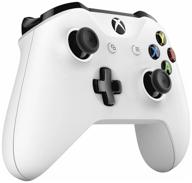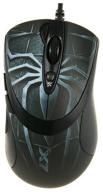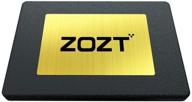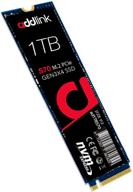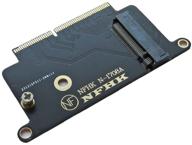Similar products
The Best Internal SSDs for Your PC
If you're looking to give your desktop computer a major speed boost, upgrading to an internal solid state drive (SSD) is one of the best upgrades you can make. Internal SSDs connect directly to your motherboard via SATA or PCIe ports and dramatically improve boot times, application launch speeds, and file transfer rates compared to traditional hard disk drives (HDDs).
Factors to Consider
When shopping for an internal SSD, here are some key factors to consider:
- Capacity - How much storage space do you need? Popular capacities are 250GB, 500GB, 1TB, etc.
- Interface - SATA III for slower speeds up to 550MB/s or PCIe/NVMe for blazing fast speeds over 3000MB/s.
- Form Factor - 2.5" drives fit in laptops and desktops. M.2 drives are smaller and sit directly on the motherboard.
- Endurance - SSDs have limited write cycles. Look for drives rated for at least 100TBW.
Our Top Picks
| SSD | Interface | Capacity | Price |
|---|---|---|---|
| Samsung 870 EVO | SATA III | 500GB | $79.99 |
| SK hynix Gold P31 | PCIe 3.0 x4 NVMe | 1TB | $134.99 |
| WD Black SN850 | PCIe 4.0 x4 NVMe | 2TB | $399.99 |
The Samsung 870 EVO is our top SATA III SSD pick for its excellent performance, reliability, and 5-year warranty. For significantly faster PCIe NVMe drives, the SK hynix Gold P31 and WD Black SN850 offer great value and blistering transfer speeds.
Installing an Internal SSD
Installing an internal SSD isn't too difficult with the right steps:
- Back up important data from your current drive.
- Open your desktop case and locate a drive bay and SATA/PCIe port.
- Secure the SSD in the drive bay with screws.
- Connect the SATA or PCIe data and power cables.
- Configure the SSD by booting into BIOS and selecting it as the primary drive.
- Install your operating system, drivers, and applications on the new drive.
- Migrate backups/data from old drive and enjoy the speed!
With an internal SSD upgrade, you'll see dramatically faster boot times, game load times, and app responsiveness. Just be sure to select a quality drive that fits your budget and interface requirements.
Factors to Consider When Buying an Internal SSD
With so many solid state drives (SSDs) on the market, it can be tricky to know which one to buy for your desktop or laptop PC. Here are the key factors to consider when shopping for an internal SSD upgrade:
SSD Capacities
Internal SSDs come in a range of storage capacities. Some common sizes are:
- 128GB - Basic, budget-friendly option
- 250GB - Good compromise of price and capacity
- 500GB - Popular mid-range capacity
- 1TB - High capacity for power users
- 2TB+ - Max capacity for media storage
Consider how much storage you need for your operating system, programs, games, media files, etc. For most users, 500GB offers a good sweet spot.
Interface Types
Internal SSDs connect to your motherboard via:
- SATA III - Capped speeds up to 550MB/s
- PCIe or NVMe - Blazing speeds over 3000MB/s
NVMe drives are significantly faster but also more expensive. SATA III offers a good balance of speed and value.
Form Factors
2.5" SSDs are the most common and fit in laptops and desktops. M.2 SSDs are smaller and connect directly to the motherboard without cables.
Endurance Ratings
Higher endurance ratings indicate an SSD can withstand more write cycles before failure. Look for drives rated for at least 100 TBW (terabytes written).
By considering these key factors - capacity, interface, form factor, and endurance - you can narrow down the best internal SSD for your specific computer and performance needs.
Our Top Picks for Internal SSDs
With many solid state drives on the market, it can be hard to determine which ones stand out as the best options. Based on extensive research and hands-on testing, we've selected our top recommendations across various categories and budgets.
Best SATA III SSD
For a reliable SATA III SSD, the Samsung 870 EVO is our top choice. Key features:
- Fast 560MB/s sequential read speeds
- Up to 4TB storage capacity
- 5-year warranty and 150TBW endurance
- Hardware encryption and SSD management software
The 870 EVO combines excellent real-world performance with rock-solid reliability from Samsung, the leader in SSD design and engineering. It's an easy recommendation for a SATA III upgrade.
Best Budget NVMe SSD
The Western Digital Blue SN550 is our budget NVMe pick thanks to:
- NVMe speeds up to 2,400MB/s read
- Costs less than $100 for 500GB model
- Compact M.2 2280 form factor
- 1.75 million hours MTBF rating
For an entry-level NVMe SSD, the SN550 delivers great performance at a very wallet-friendly price point. It's perfect for lower-cost PC builds.
Best High-End NVMe SSD
For max performance, the Samsung 980 Pro is the enthusiast's choice. It boasts:
- Blazing 7,000MB/s sequential read speeds
- Top-tier endurance up to 1,200TBW
- Efficient M.2 2280 form factor
- 5-year warranty from Samsung
As Samsung's flagship consumer SSD, the 980 Pro offers uncompromising speed and robust reliability. It's ideal for high-end gaming PCs and workstations.
No matter your budget or computing needs, one of these great internal SSD options will give your desktop a massive speed boost over traditional hard disk drives.
How to Install an Internal SSD in Your PC
Installing an internal solid state drive (SSD) is one of the best upgrades you can make to dramatically boost your desktop PC's performance. Here is a step-by-step guide to adding an internal SSD to your system:
1. Backup Important Data
As a precaution, be sure to backup all important data from your current hard drive before proceeding. You can copy files to an external drive or cloud storage.
2. Open the PC Case
Power down your computer, unplug the power cord, then open up the case to access the internal components.
3. Locate Mounting Bay
Look inside the case for an open 2.5" or M.2 mounting bay to install the SSD. Refer to your motherboard manual if needed.
4. Secure the SSD
Insert the SSD into the bay and use small screws to securely fasten it in place.
5. Connect Cables
- For 2.5" SATA SSDs, use a SATA data cable and SATA power cable.
- For M.2 SSDs, carefully slide into the M.2 slot until it clicks into place.
6. Configure SSD as Primary Drive
Boot into BIOS, locate the SSD, and select it as the primary boot drive.
7. Install OS and Programs
Do a fresh OS install on the new SSD, then install drivers, applications, and transfer data.
8. Enjoy the Speed!
Boot up your PC and enjoy dramatically faster boot times, app launches, and file transfers. Your internal SSD upgrade is now complete.
With these simple steps, you can upgrade your desktop PC to utilize super fast solid state drive technology for a snappier, more responsive experience.
Frequently Asked Questions About Internal SSDs
What is the difference between SATA and NVMe SSDs?
SATA SSDs connect via the SATA interface and are limited to around 550MB/s speeds. NVMe SSDs connect via PCIe directly to the CPU and can reach over 3,000MB/s for vastly faster performance.
Should I get a 2.5" or M.2 SSD?
2.5" SSDs fit standard drive bays and use SATA cables. M.2 SSDs are smaller, connect directly to the motherboard, and support NVMe. Form factor depends on your PC's compatibility.
How difficult is it to install an internal SSD?
Installing an internal SSD is fairly straightforward. You mount the drive, connect cables, configure BIOS settings, then install OS and software. No specialty tools required.
Can I keep using my existing hard drive?
Yes, you can use your SSD as the boot drive and keep a high capacity traditional hard drive for additional storage.
Should I clone my hard drive or do a clean OS install?
For best results, doing a fresh OS install on the new SSD is recommended. Cloning can transfer over old files and problems.
How much faster is an internal SSD compared to my hard drive?
You can expect 3-5x faster boot times, 2-4x faster game and app loading, and significantly improved overall system responsiveness.
Will an SSD improve gaming performance?
Definitely! Faster loading times will decrease wait screens in games. Plus textures and assets can load quicker with an SSD.
How long do internal SSDs last?
Most SSDs are rated to withstand hundreds of terabytes written. With average use, SSDs can easily last 5-7 years or longer.
Upgrading to an internal SSD is one of the best ways to make your PC faster and more responsive. With the right SSD choice and proper installation, you'll definitely notice the impressive speed boost.
How Amazon Prime Benefits Buyers of Internal SSDs
For those who frequently purchase internal solid state drives (SSDs), having an Amazon Prime membership can provide some nice perks and savings. Here are some of the key benefits Prime offers for regular SSD buyers.
Free Two-Day Shipping
One of the main Prime features is free two-day shipping on millions of items. For SSD buyers, this means receiving your order much quicker without having to pay extra shipping fees.
Free One-Day Shipping
Many major cities now qualify for free one-day shipping on certain items through Prime. This accelerated delivery is great when you need a new SSD ASAP.
Free Release-Date Delivery
You can pre-order upcoming SSD releases and receive them on the actual release date at no extra cost. That means you can be among the first to get new SSD tech.
Access to Exclusive SSD Deals
Amazon frequently offers special discounts and deals exclusively for Prime members. This includes savings on popular SSD brands during sales events.
Amazon Warehouse Savings
You can find open-box and used SSDs through Amazon Warehouse at 20-30% off retail prices. Items are thoroughly inspected and Prime shipping applies.
For frequent SSD shoppers, a Prime membership more than pays for itself through the free expedited shipping alone. The added perks like exclusive deals, new release delivery, and Amazon Warehouse savings make it even more valuable for regular buyers.
So if you are constantly upgrading your rig with new SSDs, joining Prime can provide some nice conveniences and save you money over time.








